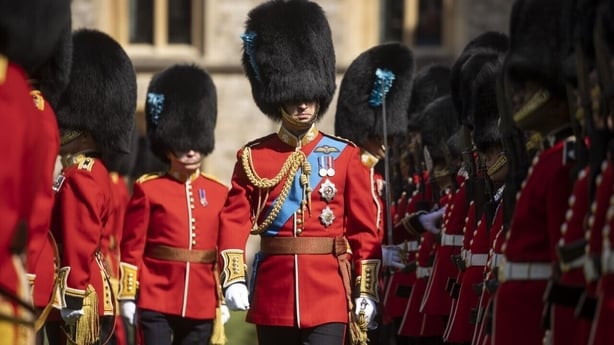Queen Elizabeth's Platinum Jubilee celebrations began in Britain with strains of 'Spancil Hill' as the Irish Guards known as 'The Micks' were given the task of Trooping the Colour.
The ceremony is performed every year for the Queen's birthday, but the honour of carrying it out for her 70th anniversary was given to the Irish Guards - a regiment in the British army since 1900.
According to military websites, the Trooping the Colour ceremony has its centuries old origin in the daily practice of parading the regimental colours or flag in front of the soldiers every day to emphasise its status as the rallying point during battle.
Performing the ceremony for the sovereign's birthday dates back to 1760 and the reign of George III.
However, this was not one of the events that the Queen was due to attend because of her mobility difficulties.
The modern day ceremony, which began at 11am, involved over 1,200 soldiers and 240 horses and is said to be both physically and mentally demanding, as there are 113 different commands to be memorised for the 90-minute event.
It involved a guard of honour in Horse Guard Parade and a procession down the Mall.
The Irish Guards were joined by bandsmen and other regiments, including the Household Cavalry who had a Rastafarian taking part for the first time.
While on their ceremonial duties, the Irish Guards can be identified by their tunic buttons bearing the Harp of Ireland, arranged in two groups of four as they were the fourth guards regiment to be formed, with a shamrock on the collar and a blue plume worn on the right side of the bearskin.
The blue represents St Patrick and some argue it was the original symbolic colour of Ireland.
The regiment receives shamrock every year from the Duke and and Duchess of Cambridge and it is the only regiment to be allowed to bring their wolfhound mascot - currently Turlough Mór - on parade.
The Irish flavour continued during the ceremony, with a special musical arrangement of 'Spancil Hill' and the 'Cliffs of Dooneen' called 'Mists of the Shannon' played for the royal inspection.
Programme notes explain: "The Shannon River is the longest running river in the British Isles and can be seen from the Cliffs of Dooneen.
"It separates the counties of Clare and Kerry, from where the two tunes originate. The river is often covered by gentle mists which are referred to by locals as the mists of the Shannon".
Then more upbeat marching tunes included, 'I'll Tell me Ma’, 'Paddy McGinty’s Goat' and 'MacNamara's Band'.
Prince William was appointed Colonel of the Irish Guards in 2011 and recently presented the regiment with their new colours. He lead them during the Trooping the Colour ceremony.

The Irish Guards regiment was formed by Queen Victoria in 1900 to commemorate the contribution of the Irish soldiers during the Second Boer War.
In Dublin, the Fusiliers' Arch at the Grafton Street entrance to St Stephen's Green also commemorates those who fought for the British Empire against the Boers or Afrikaaners in South Africa.
Erected in 1907 it became known as 'Traitor's Gate' because Irish Nationalists of that time supported the Boers.
The regiment originally consisted of men of Irish descent from other regiments in the British Army but it now takes recruits from Great Britain generally and from around the world.
Most Irish recruits are from Northern Ireland and usually from the Loyalist community. However, there are also some from the Republic and they included Lance Corporal Ian Malone from Dublin, who was killed in the Iraq War in 2003.
During The Troubles the Irish Guards were exempted from service in Northern Ireland until the reduction in British army numbers following the end of the Cold War made it necessary and they were first stationed there in 1992.
However, the Irish Guards were the target of an IRA attack in 1981, when a bomb outside Chelsea barracks killed two civilians and wounded 43 people, including 23 soldiers.
The regiment served in both world wars and was present during the Palestine mandate, in Egypt during the Suez Crisis, in what is now Yemen during the 'Aden Emergency' and in Cyprus and Kosovo and more recently in Afghanistan and Iraq.
It is currently one of the most active regiments in the army, with deployments including Africa, The Baltics and Belize.
According to its website, "the work we do ranges from peacekeeping to providing humanitarian aid, from enforcing anti-terrorism measures to helping combat the international drugs trade".







